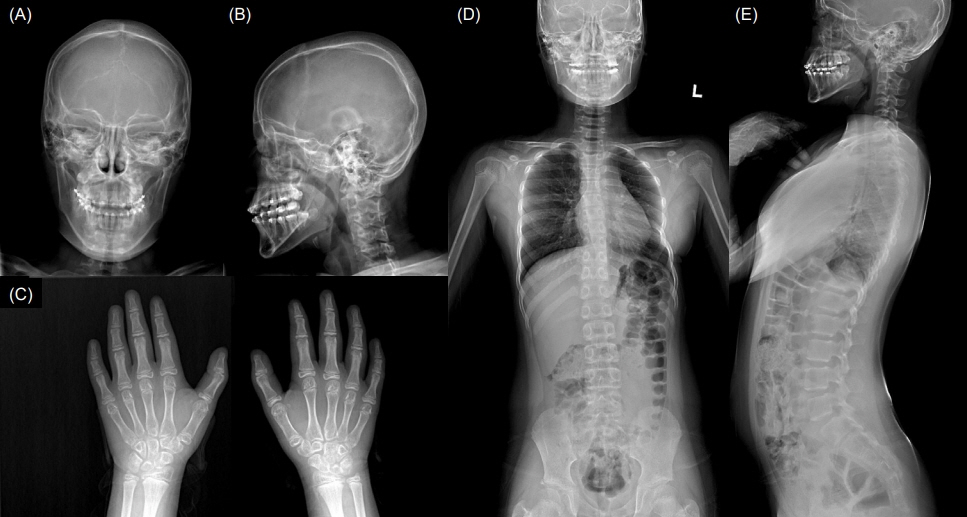Ann Pediatr Endocrinol Metab.
2021 Sep;26(3):210-214. 10.6065/apem.2040214.107.
Myhre syndrome: the first case in Korea
- Affiliations
-
- 1Department of Pediatrics, Inje University Ilsan Paik Hospital, Goyang, Korea
- 2Department of Pediatrics, Seoul National Universit y Bundang Hospital, Seongnam, Korea
- KMID: 2520515
- DOI: http://doi.org/10.6065/apem.2040214.107
Abstract
- Myhre syndrome (MS) is a rare autosomal-dominant disorder characterized by short stature, intellectual disability, skeletal anomalies, restricted joint mobility, distinctive facial dysmorphism, and deafness. Early diagnosis of MS is difficult because its features progress and become noticeable at school age. Recently, the SMAD4 gene was identified as the major gene responsible for MS. Herein, we report the first Korean case of MS after identification of a SMAD4 mutation by clinical exome sequencing. The patient was born small for gestational age, and she had the typical clinical features of MS, including short stature, characteristic facial appearance, developmental delay, and selective mutism. She was diagnosed with central precocious puberty. Because of the patient’s precocious puberty and short stature, we administered combined recombinant human growth hormone and gonadotropin-releasing hormone agonist treatments, which resulted in improved height. While there have been 79 cases of MS reported worldwide, to our knowledge, this is the first case of genetically-confirmed MS in Korea.
Keyword
Figure
Reference
-
References
1. Caputo V, Bocchinfuso G, Castori M, Traversa A, Pizzuti A, Stella L, et al. Novel SMAD4 mutation causing Myhre syndrome. Am J Med Genet A. 2014; 164A:1835–40.2. Le Goff C, Michot C, Cormier-Daire V. Myhre syndrome. Clin Genet. 2014; 85:503–13.
Article3. Starr LJ, Lindor NM, Lin AE. Myhre Syndrome. In : Adam MP, Ardinger HH, Pagon RA, Wallace SE, Bean LJH, Stephens K, editors. GeneReviews((R)). Seattle (WA): University of Washington, Seattle;GeneReviews is a registered trademark of the University of Washington, Seattle. All rights reserved.1993.4. Garavelli L, Maini I, Baccilieri F, Ivanovski I, Pollazzon M, Rosato S, et al. Natural history and life-threatening complications in Myhre syndrome and review of the literature. Eur J Pediatr. 2016; 175:1307–15.
Article5. Li H, Cheng B, Hu X, Li C, Su J, Zhang S, et al. The first two Chinese Myhre syndrome patients with the recurrent SMAD4 pathogenic variants: Functional consequences and clinical diversity. Clin Chim Acta. 2020; 500:128–34.
Article6. Richards S, Aziz N, Bale S, Bick D, Das S, Gastier-Foster J, et al. Standards and guidelines for the interpretation of sequence variants: a joint consensus recommendation of the American College of Medical Genetics and Genomics and the Association for Molecular Pathology. Genet Med. 2015; 17:405–24.
Article7. Nomura R, Miyai K, Nishimura G, Kashimada K, Morio T. Myhre syndrome: age-dependent progressive phenotype. Pediatr Int. 2017; 59:1205–6.
Article8. Alagia M, Cappuccio G, Pinelli M, Torella A, BrunettiPierri R, Simonelli F, et al. A child with Myhre syndrome presenting with corectopia and tetralogy of Fallot. Am J Med Genet A. 2018; 176:426–30.
Article9. Burglen L, Heron D, Moerman A, Dieux-Coeslier A, Bourguignon JP, Bachy A, et al. Myhre syndrome: new reports, review, and differential diagnosis. J Med Genet. 2003; 40:546–51.
Article10. Evereklioglu C, Hepsen IF, Er H. Weill-Marchesani syndrome in three generations. Eye (Lond). 1999; 13(Pt 6):773–7.
Article11. Varenyiova Z, Hrckova G, Ilencikova D, Podracka L. Myhre syndrome associated with Dunbar syndrome and urinary tract abnormalities: a case report. Front Pediatr. 2020; 8:72.
Article12. Le Goff C, Mahaut C, Abhyankar A, Le Goff W, Serre V, Afenjar A, et al. Mutations at a single codon in Mad homology 2 domain of SMAD4 cause Myhre syndrome. Nat Genet. 2011; 44:85–8.
Article13. Dawes LJ, Sleeman MA, Anderson IK, Reddan JR, Wormstone IM. TGFb et a/Smad4-dependent and-independent regulation of human lens epithelial cells. Invest Ophthalmol Vis Sci. 2009; 50:5318–27.
Article14. Walton KL, Johnson KE, Harrison CA. Targeting TGF-beta mediated SMAD signaling for the prevention of fibrosis Front Pharmacol. 2017; 8:461.15. Lin AE, Michot C, Cormier-Daire V, L'Ecuyer TJ, Matherne GP, Barnes BH, et al. Gain-of-function mutations in SMAD4 cause a distinctive repertoire of cardiovascular phenotypes in patients with Myhre syndrome. Am J Med Genet A. 2016; 170:2617–31.16. Michot C, Le Goff C, Mahaut C, Afenjar A, Brooks AS, Campeau PM, et al. Myhre and LAPS syndromes: clinical and molecular review of 32 patients. Eur J Hum Genet. 2014; 22:1272–7.
Article17. Geisheker MR, Heymann G, Wang T, Coe BP, Turner TN, Stessman HAF, et al. Hotspots of missense mutation identify neurodevelopmental disorder genes and functional domains. Nat Neurosci. 2017; 20:1043–51.
Article18. McGowan R, Gulati R, McHenry P, Cooke A, Butler S, Keng WT, et al. Clinical features and respiratory complications in Myhre syndrome. Eur J Med Genet. 2011; 54:e553–9.
Article19. Alape D, Singh R, Folch E, Fernandez Bussy S, Agnew A, Majid A. Life-threatening multilevel airway stenosis due to Myhre syndrome. Am J Respir Crit Care Med. 2020; 201:731–2.
Article20. Yu KP, Luk HM, Chung BH, Lo IF. Myhre syndrome: a report of six Chinese patients and literature review. Clin Dysmorphol. 2019; 28:145–50.
Article




